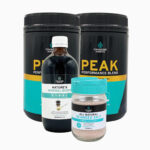I’ve just come back from 10 days in the USA interviewing people on all aspects of wheat and gluten and why in the last few decades, and more so in the last decade, is wheat and gluten a problem and the gluten-free food business becoming a multibillion dollar industry worldwide.
Over the last four years since I realised that wheat was playing havoc with my body, with respect to aches and pains, sore back, painful hip and weight gain, I’ve been on a huge learning curve to find out why wheat is all of a sudden the new danger food.
Dr William Davies in his book Wheat Belly says it is the hybridisation of wheat and the super gluten and super amylopectin (sugar) that is the main culprit. Dr David Perlmutter in his book Grain Brain writes it is all about the inflammation that wheat and grain creates as well as the oligosaccharides causing high blood sugar that may be the culprit – perpetuating dementia, multiple sclerosis, Parkinson’s, tremors, ADD, autism and other central nervous system maladies.
It seems that everyone has a different take on what is happening.
But as I interviewed more and more people, such as Vandina Shiva, Dr Sarah Ballantyne, Dr Terry Wahls, Sayer Ji (GeenMedInfo), Dr Leo Galland, Dr Natasha Campbell McBride, Sally Fallon, Joel Salatin, Mark Sisson and Dr Stephanie Seneff, I realised it has been a cascade of events that has created the perfect storm with our inability to consume, digest, absorb and use a grain of wheat without it causing immune system chaos for many people whether they know it or not.
Can we live without wheat? Most definitely! Do we want to live without wheat? Now that’s a question many people struggle to come to grips with.
I was brought up in the 60’s and the 70’s and my mum made cakes, pies, bread, muffins and many delicious treats with wheat. She learnt from her mother the art of cooking and my grandmother learnt from her mother and then for 10,000 years and possibly 100,000 years we have been eating grasses and grains.
The common thread I hear for the reason not to eat grain in modern times is that we have not adapted genetically to eating wheat (grain) over the last 10,000 years or more. But the more I researched the more I found that it is not so much about how we as humans have genetically changed to eat wheat, but rather how our microbiome (bacteria in our gut) adapts to our changing diet, which allows spontaneous adaptation.
Let’s take the Hadza study done in 2014 to explain this theory. The Hadza’s are a race of hunter gatherers who live in Tanzania and eat mainly meat and tuberous root vegetables, such as sweet potato or desert yam. They do not have modern day diseases and they live into their 70’s and beyond. They took stool (poo) samples from 20 Hadza’s ranging from the ages of 5 to 70. The researchers’ aim was to look at the microbiome (bacteria, virus, parasites in the GUT) of the Hadza and compare it to the modern microbiome.
To their surprise there was no bifidus bacteria in the stool samples of the Hadza’s – a very common bacteria in the western microbiome, but currently being destroyed by the use of broad spectrum antibiotics and other medications and chemicals used in food and the production of food.
A theory has been formed from this, confirmed by Dr Leo Galland and Sally Fallon, that Bifidus is a bacteria that helps humans break down proteins (gluten) into small peptides and amino acids, allowing for digestion, absorption and utilisation without creating immune system havoc. Perhaps the introduction of bifidus into the human microbiome was when grain and wheat were introduced in order for humans to digest, absorb and utilise grain for their survival.
Over the last decade there has been a plethora of information regarding the importance of the microbiome in the survival of the individual. Functions of the microbiome that we know of include:
1. immunity and protection
2. make B vitamins and Vitamin K
3. influence on tryptophan and serotonin production
4. digestion and absorption of nutrients
5. protection of the epithelial lining of the GUT
6. enhance communication with cells
7. correct food choices
8. protection from heavy metals
9. brain and mental health (GUT – brain axis)
10. physical health and prevention of disease.
As research continues I’m sure we will find many more functions of the microbiome. The microbiome plays a key role in our health and ability to digest different foods in order to adapt to our environment, the foods we consume and our ability to be robust in an ever changing world.
I now realise that it’s not one thing that is causing the increase in coeliac disease and non-coeliac gluten sensitivity and the exponential growth in nervous system related diseases and autoimmunity, but rather a cascade of events that has created the demise of our ability to use wheat and gluten. I am so excited about the documentary on this very topic that my team and I are putting together. Some of the scientists I interviewed hope we can make a change while others had a somewhat doomsday prophecy as to whether we can halt and reverse this rise in physical and mental disease and our ability to consume wheat and gluten.
Happy Changing Habits,
Cyndi








0 Comments